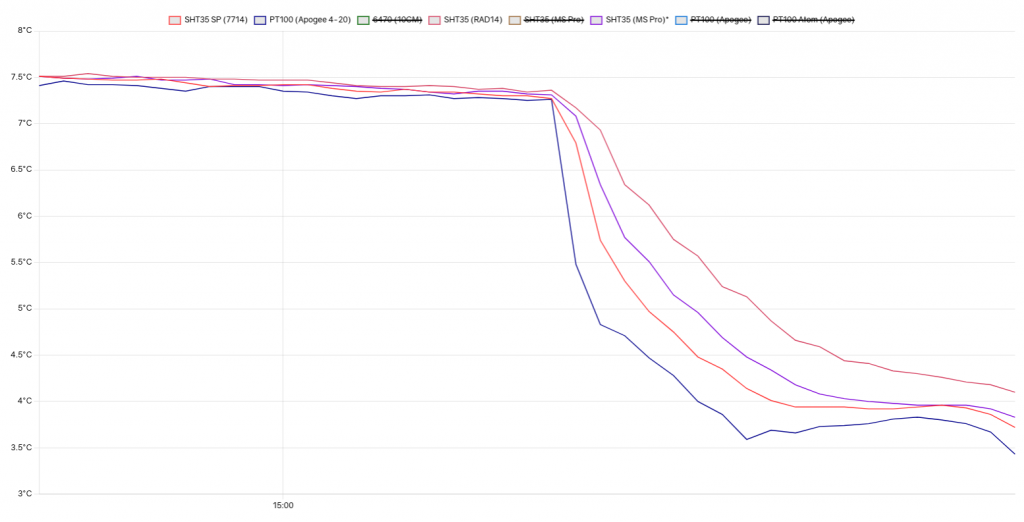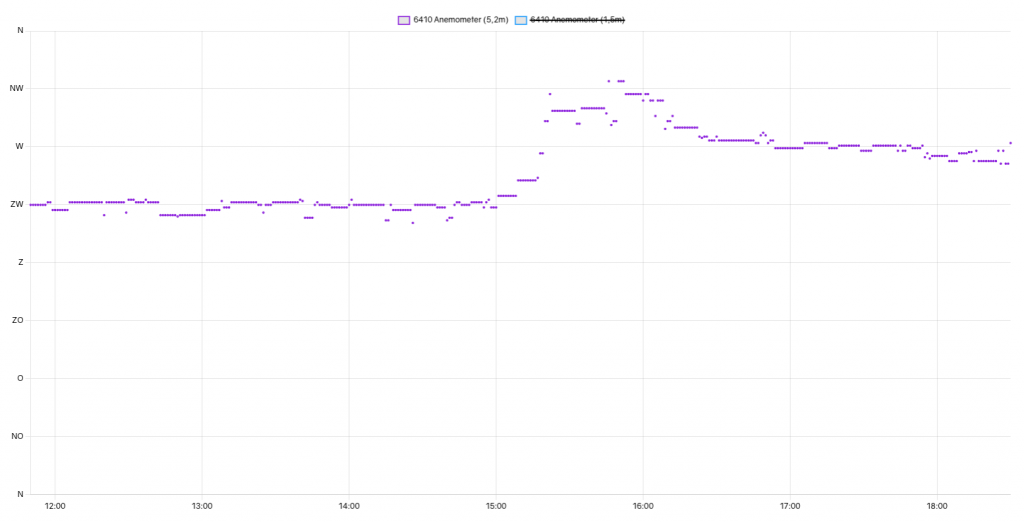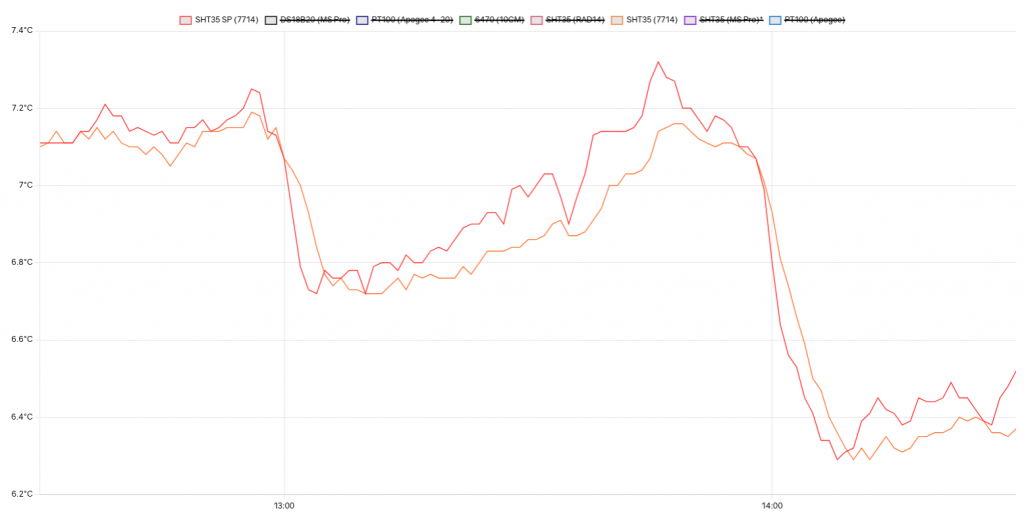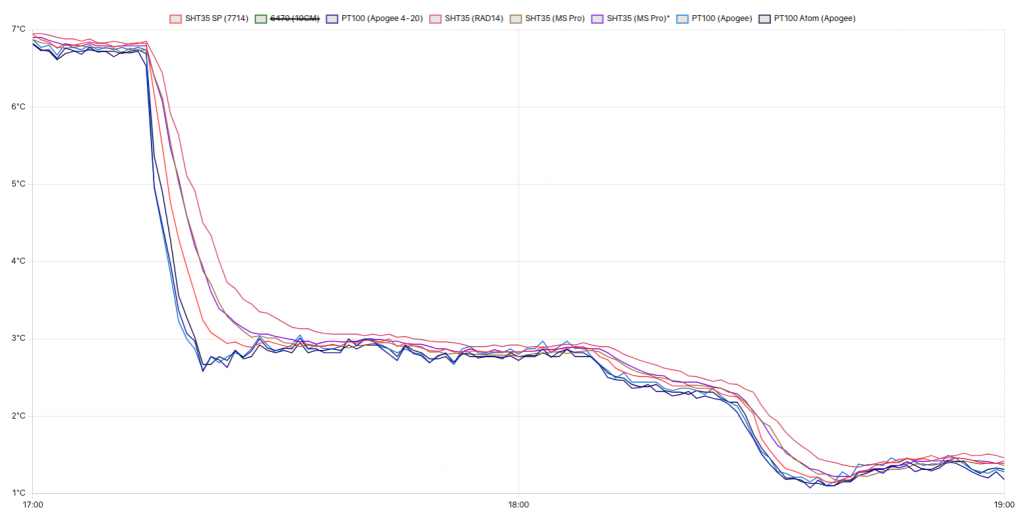The passing of a sharp weather front, accompanied by a sudden increase or decrease in temperature, is a good occasion to analyze temperature sensor behavior. Especially apparent becomes the responsiveness of different sensors.
February 4th 2022 didn’t see any spectacular weather, but during the afternoon a cold front passed over which caused a very abrupt drop in temperature. At 15.11, all sensors immediately responded. But some did so more pronounced than others.

Above graph shows temperature data from 7 separate sensors in 5 different radiation shields. These can be grouped into 4 different configurations:
- 2 Barani MeteoShield Pro shields with identical SHT35 plastic probes
- SHT35 plastic probe inside a MetSpec RAD14
- SHT35 steel probe inside a Davis Instruments 7714
- 3 PT100 sensors inside an Apogee Instruments TS-100 fan aspirated shield
These configurations result in 4 different graph trajectories. For clarity I’ve filtered out a single line per configuration.

For more context, I will also add graphs for wind speed and direction.


Especially wind speed is relevant. At 15.11, wind speeds average around 3 m/s at sensor level. These drop off sharply too, but that only happens around 5 or 6 minutes later. The first 10 minutes after temperatures drop, the passive shields still receive gusts up to 3 m/s. A last fact: solar radiation was very low at the time (around 10 W/m2).
As for the temperature, the 4 lines show a significant difference in responsiveness. Let me start with the fastest response time.
The PT100 sensors inside the Apogee shield cool down the quickest. Arguably, this makes sense. The Apogee TS-100 is actively ventilated, so at all times the sensors receive a steady breeze, allowing them to pick up changes is ambient temperature quicker. Probably more importantly (considering wind speeds) the PT100 sensors are said to be quite responsive in themselves. They are housed inside stainless steel probe casings, which appear to transfer temperature changes to the sensor inside quicker in general.
This effect can also be seen in the SHT35 sensor inside the stainless steel probe casing. It consistently responds quicker than the identical sensor type inside the plastic probe casings.


Below is a (fairly random) example of these two sensors, both housed in a Davis 7714 radiation shield.

The red line is the steel probe. Both temperature drops around 13:00 and 14:00 illustrate how that sensor picks up the temperature change faster than the plastic probe.
Returning to the first case, it is clear that all three SHT35 sensors housed in plastic probe casings respond with the largest delay to the cold front. There is a significant difference between the Barani MeteoShield Pro and the MetSpec RAD14, though.
If we pick a benchmark and look at how long it takes each sensor to fall to 4 degrees, we see the PT100 sensors take about 6 minutes to drop to that temperature. The SHT35 in the Barani shield takes 13 minutes, while it’s only after 20 minutes that the sensor inside the RAD14 cools that far. It takes more than an hour for all sensors to converge around the same values again.

Especially the RAD14 sensor lags behind and only really seems to catch up with the other sensors because the temperature started rising again slightly.
This pattern, with the actively ventilated PT100 leading and the RAD14 shield catching up last, can be seen in most if not all cases of rapid temperature shifts. Today, February 6th, saw a cold upper atmosphere with showers causing similar temperature drops resulting in very similar graphs.

In general, we could conclude that the MeteoShield Pro is superior to the RAD14 where ventilating the sensor is concerned. As for the others, I am tempted to conclude from this data that the PT100 is indeed very responsive. But of course, most of these comparisons are not exactly fair. All 3 PT100 sensors are actively ventilated, while the rest is not. At the same time, the conditions mentioned above (3 m/s winds) should have allowed for sufficient ventilation of the passive shields to limit the advantage of the Apogee TS-100. Nonetheless, a proper comparison should be made between different sensors in the same type of shield. The plastic probe won’t properly fit alongside the PT100 in the TS-100, but I will be comparing the PT100 and SHT35 plastic probe in a MeteoShield Pro. When I have significant data for those setups, I will add the results to this topic.